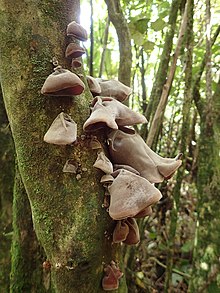Auricularia cornea, also known as cloud ear, is a species of fungus in the order Auriculariales. It is commercially cultivated for food in China. Auricularia cornea is a popular ingredient in many Chinese dishes and is also used in traditional Chinese medicine.
| Auricularia cornea | |
|---|---|

| |
| Auricularia cornea, New Zealand | |
| Scientific classification | |
| Domain: | Eukaryota |
| Kingdom: | Fungi |
| Division: | Basidiomycota |
| Class: | Agaricomycetes |
| Order: | Auriculariales |
| Family: | Auriculariaceae |
| Genus: | Auricularia |
| Species: | A. cornea
|
| Binomial name | |
| Auricularia cornea Ehrenb. (1820)
| |
| Synonyms | |
| |
Taxonomy
editAuricularia cornea was originally described from Hawaii (Oahu) by German naturalist Christian Gottfried Ehrenberg in 1820. It was accepted as a distinct species by Bernard Lowy in his 1952 world monograph of Auricularia[1] and subsequently confirmed as distinct by molecular research, based on cladistic analysis of DNA sequences.[2]
Formerly, Auricularia cornea was often misidentified as A. polytricha.[3] That species was originally described from the Eastern Ghats in India by French mycologist Camille Montagne in 1834, and is now considered as a synonym of A. nigricans.[2] The misidentification remains widespread, at least in Japan.[4]
Vernacular names
editThe species is one of several gelatinous fungi known as wood ear, wood fungus, ear fungus, or tree ear fungus, which alludes to their rubbery, ear-shaped fruitbodies.[5]
In Hawaii, it is known as pepeiao which means "ear"[6] In Chinese cooking, it is often referred to as "black treasure".[7] In New Zealand, it is known as hakeke by Māori.[8][5]
Description
editFruit bodies are solitary or clustered, ear-shaped, laterally attached to wood, sometimes by a very short stalk, elastic, gelatinous, pale brown to reddish brown, rarely white, up to 90 millimetres (3+1⁄2 inches) wide and 2 mm thick. The upper surface is densely hairy and the lower surface is smooth. Microscopically, the hairs on the upper surface are thick-walled, 180–425 × 6–9 μm. The basidia are cylindrical, hyaline, three-septate, 60–75 × 4–6 μm. The spores are hyaline, allantoid (sausage-shaped), and 14–16.5 × 4.5–6 μm.[3]
Habitat and distribution
editAuricularia cornea grows on dead fallen or standing wood of broadleaf trees. The species is widely distributed in southern Asia, Africa, Australasia and the Pacific, and South America.[2][3]
Uses
edit100 g of dry cloud ear fungus contains 70.1 g of dietary fibre.[9]
Auricularia cornea is usually sold in dried form, and needs to be soaked in water before use.[citation needed] While almost tasteless, it is prized for its slippery but slightly crunchy texture, and its potential nutritional benefits.[10] The slight crunchiness persists despite most cooking processes.[11] Auricularia cornea is coarser than A. heimuer, and is more likely to be used in soups rather than stir fries.[12]
Māori traditionally cooked wood ear fungus by steaming in an earth oven and eating with sow thistle and potatoes.[13] From the 1870s to the 1950s, the fungus was collected and exported from New Zealand to China.[8][5] The white, unpigmented form is now cultivated in China.[3][14]
According to Chinese medicine practitioners, eating dried and cooked wood ear can have health benefits for people with high blood pressure or cancer, and can prevent coronary heart disease and arteriosclerosis.[7]
This fungus is used in Cantonese desserts.
See also
editReferences
edit- ^ Lowy, Bernard (1952). "The genus Auricularia". Mycologia. 44 (5): 656–92. doi:10.1080/00275514.1952.12024226. ISSN 0027-5514. JSTOR 4547639.
- ^ a b c Looney, B. (2013). "Systematics of the genus Auricularia with an emphasis on species from the southeastern United States". North American Fungi. doi:10.2509/naf2013.008.006 (inactive 2024-11-10). ISSN 1937-786X.
{{cite journal}}: CS1 maint: DOI inactive as of November 2024 (link) - ^ a b c d Wu F, Tohtirjap A, Fan L, Zhou L, Alvarenga RL, Gibertoni TB, Dai Y (2021). "Global diversity and updated phylogeny of Auricularia (Auriculariales, Basidiomycota)". Journal of Fungi. 7 (11): 933. doi:10.3390/jof7110933. PMC 8625027. PMID 34829220.
- ^ 貴, 白水; 重樹, 稲葉; 秀爾, 牛島; 康仁, 奥田; 栄史, 長澤 (2018). "日本産 "Auricularia auricula-judae " および" A. polytricha " の分子系統解析と形態比較に基づく分類学的検討". 日本菌学会会報. 59 (1): jjom.H30–02. doi:10.18962/jjom.jjom.H30-02.
- ^ a b c Sisson, Liv (2023). Fungi of Aotearoa : a curious forager's field guide. Auckland, New Zealand: Penguin Random House New Zealand. ISBN 9781761047879.
- ^ Elizabeth Speith. "Auricularia polytricha (Auriculariaceae) - HEAR species info". Hear.org. Retrieved 2011-02-28.
- ^ a b "Cuisine - Food - Cloud ear fungus". China Daily. 28 February 2011. Retrieved 4 May 2016.
- ^ a b Stephen Brightwell. "Feasting on Fungi". Retrieved 15 October 2018.
- ^ "Fungi, Cloud ears, dried". National Nutrient Database. Archived from the original on April 3, 2019. Retrieved December 13, 2018.
- ^ Smith, Lana Billings. "The nutritional benefits of wood ear fungus". www.livestrong.com. Retrieved 5 May 2016.
- ^ "Why wood ear fungus should be a part of your daily meals". Organic Olivia. Archived from the original on 6 February 2017. Retrieved 5 May 2016.
- ^ So, Yan-kit (16 January 2015). Yan-Kit's Classic Chinese Cookbook. Penguin. p. 248. ISBN 9781465439758.
- ^ Riley, Murdoch (1988). Maori Vegetable Cooking: Traditional and Modern Methods. New Zealand: Viking Sevenseas NZ Ltd. p. 6.
- ^ Bandara AR, Mortimer PE, VadthanaratS, Xingrong P, Karunarathna SC, Hyde KD, Kakumyan P, Xu J (2020). "First successful domestication of a white strain of Auricularia cornea from Thailand". Studies in Fungi. 5 (1): 420–434. doi:10.5943/sif/5/1/23. S2CID 234995383.
External links
edit- Black Fungus
- Chinese Cuisine - Cloud Ears and Wood Ears Archived 2005-09-19 at the Wayback Machine